Magic lantern

The magic lantern or laterna magica is an early type of image projector employing painted pictures or photographs on sheets of glass, a lens and a bright light source. It was mostly developed in the 17th century and commonly used for entertainment purposes. It became a common medium for educational purposes around 1800 until it was succeeded by slide projectors in the 1950s.
Technology

The magic lantern used a concave mirror in back of a light source to direct as much of the light as possible through a small rectangular sheet of glass—a "lantern slide"—on which was the image to be projected, and onward into a lens at the front of the apparatus. The lens was adjusted to optimally focus the plane of the slide at the distance of the projection screen, which could be simply a white wall, and it therefore formed an enlarged image of the slide on the screen.[1] Some lanterns, including those of Christiaan Huygens and Jan van Musschenbroek, used 3 lenses.
Originally the pictures were hand painted on glass slides. Initially figures were rendered with black paint but soon transparent colors were also used. Sometimes the painting was done on oiled paper. Usually black paint was used as a background to block superfluous light, so the figures could be projected without distracting borders or frames. Many slides were finished with a layer of transparent lacquer, but in a later period cover glasses were also used to protect the painted layer.[2] Most hand-made slides were mounted in wood frames with a round or square opening for the picture.[3]
After 1820 the manufacturing of hand colored printed slides started, often making use of decalcomania transfers.[4] Many manufactured slides were produced on strips of glass with several pictures on them and rimmed with a strip of glued paper.
The first photographic lantern slides, called "Hyalotypes", were invented by the German-born brothers Ernst Wilhelm (William) and Friedrich (Frederick) Langenheim in 1848 in Philadelphia and patented in 1850.[5][6][7]
Apart from sunlight, the only light sources available at the time of invention in the 17th century were candles and oil lamps, which were very inefficient and produced very dim projected images. The invention of the Argand lamp in the 1790s helped to make the images brighter. The invention of limelight in the 1820s made them very much brighter. The invention of the intensely bright electric arc lamp in the 1860s eliminated the need for combustible gases or hazardous chemicals, and eventually the incandescent electric lamp further improved safety and convenience, although not brightness.[8]
Invention
Several types of projection systems existed before the invention of the magic lantern. For these precursors:
The magic lantern can be seen as a further development of the Camera Obscura. This is a natural phenomenon that occurs when an image of a scene at the other side of a screen (or for instance a wall) is projected through a small hole in that screen as an inverted image (left to right and upside down) on a surface opposite to the opening. It was known at least since the 5th century BCE and experimented with in darkened rooms at least since circa 1000 CE. The use of a lens in the hole has been traced back to circa 1550. The portable camera obscura box with a lens was developed in the 17th century. Dutch inventor Cornelis Drebbel is thought to have sold one to Dutch poet, composer and diplomat Constantijn Huygens in 1622,[9] while the oldest known clear description of a box-type camera is in German Jesuit scientist Gaspar Schott's 1657 book Magia universalis naturæ et artis.
In the 17th century there was an immense interest in optics. The telescope and microscope were invented (in 1608 and the 1620s respectively) and apart from being useful to some scientists, such instruments were especially popular as entertaining curiosities with people who could afford them.[10] The magic lantern would prove to be a perfect successor.
Prominent Dutch scientist Christiaan Huygens, is nowadays widely accepted as the true inventor of the magic lantern. He knew Athanasius Kircher's 1646 edition of Ars Magna Lucis et Umbrae which described a primitive projection system with a focusing lens and text or pictures painted on a concave mirror reflecting sunlight. Christiaan's father Constantijn had been acquainted with Cornelis Drebbel who used some unidentified optical techniques to transform himself and summon wonderful appearances in magical performances. Constantijn Huygens wrote very enthusiastically about a camera obscura device that he got from Drebbel in 1622.
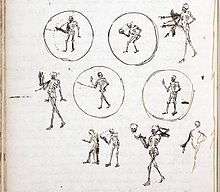
In 1659 Christiaan Huygens sketched several phases of a skeleton taking off its skull "for representations by means of convex glasses with the lamp" (translated from French).[11] Huygens probably only constructed the lantern to amuse young family members and soon seemed to regret it, as he thought it was too frivolous. In a 1662 letter to his brother Lodewijk he claimed he thought of it as some old "bagatelle" and seemed convinced that it would harm the family's reputation if people found out the lantern came from him. Christiaan had reluctantly sent a lantern to their father, but when he realized that Constantijn intended to show the lantern to the court of King Louis XIV of France at the Louvre, Christiaan asked Lodewijk to sabotage the lantern.[12]

Christiaan initially referred to the magic lantern as "la lampe" and "la lanterne", but in the last years of his life he used the then common term "laterna magica" in some notes. In 1694 he drew the principle of a "laterna magica" with two lenses.[13]

Thomas Rasmussen Walgensten, a Danish mathematician, studied at the university of Leyden in 1657-58 and was acquainted with Christiaan Huygens. It is unclear if one was inspired by the other or if they even may have collaborated on the development of the magic lantern. At least from 1664 until 1670 Walgensten was giving magic lantern shows in Paris, Lyon, Rome and Copenhagen,[10] and before 1671 he "sold such lanterns to different Italian princes in such an amount that they now are almost everyday items in Rome" according to Athanasius Kircher.[14] When Walgensten projected an image of Death at the court of King Frederick III of Denmark some courtiers were scared, but the king dismissed their cowardice and requested to repeat the figure three times. The king died a few days later.[10]
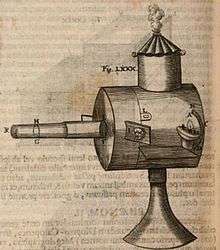
There are probably many gaps in the magic lantern's recorded history. A separate early magic lantern tradition seems to have been developed in southern Germany and includes lanterns with horizontal cylindrical bodies, while the Huygens and Walgensten lanterns probably both had vertical bodies. This tradition can be traced back to 1671 with the arrival of instrument maker Johann Franz Griendel in Nuremberg, one of the centers of magic lantern production identified by Johann Zahn in 1686. Griendel was indicated as the inventor of the magic lantern by Johann Christoph Kohlhans in a 1677 publication.[15]
Further history
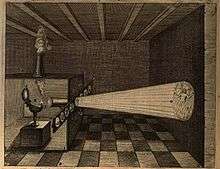

The magic lantern is presented as "Lucerna Magica" in the 1671 second edition of Athanasius Kircher's book Ars Magna Lucis et Umbrae.[16] Kircher claimed that Thomas Walgensten reworked his ideas from the previous edition into a better lantern, which Kircher then continued to describe and which was illustrated in a confusing manner.[17] The pictures seem technically incorrect with both the projected image and the transparencies (H) shown upright (while the text clearly states that they should be placed in an inverted position), the hollow mirror is too high in one picture and absent in the other, and the lens (I) seems to be placed at the wrong side of the slide.[18] The projected image in one illustrations shows a person in purgatory or hellfire and the other depicts Death with a scythe and an hourglass. According to legend Kircher secretly used the lantern at night to project the image of Death on windows of apostates to scare them back into church.[19] Kircher did suggest in his book that an audience would be more astonished by the sudden appearance of images if the lantern would be hidden in a separate room, so the audience would be ignorant of the cause of their appearance.[17]

The earliest reports and illustrations of lantern projections suggest that they were all intended to scare the audience. French engineer Pierre Petit, who saw a show by Walgensten, called the apparatus "lanterne de peur" (lantern of fear) in a 1664 letter to Huygens.[20] Surviving lantern plates and descriptions from the next decades prove that the new medium was not just used for horror shows, but that all kinds of subjects were projected.

From at least the 1730s the use of magic lanterns started to become more widespread when travelling showmen, conjurers and storytellers added them to their repertoire. The travelling lanternists were often called Savoyards (they supposedly came from the Savoy region in France) and became a common sight in many European cities.[10]
In France in the 1770s François Dominique Séraphin used magic lanterns to perform his "Ombres Chinoises" (Chinese shadows), a form of shadow play.
Magic lanterns had also become a staple of science lecturing and museum events since Scottish lecturer Henry Moyes’s tour of America in 1785–86, when he recommended that all college laboratories procure one. French writer and educator Stéphanie Félicité, comtesse de Genlis popularized the use of magic lanterns as an educational tool in the late 1700s when using projected images of plants to teach botany. Her educational methods were published in America in English translation during the early 1820s.[21] A type of lantern was constructed by Moses Holden between 1814–15 for illustrating his astronomical lectures.[22]
In 1821 Philip Carpenter's London company, that would become Carpenter and Westley after his death, started manufacturing a sturdy but lightweight and transportable "Phantasmagoria lantern" with an Argand style lamp, which produced high quality projections and was suitable for use in classrooms. Carpenter also developed a "secret" copper plate printing/burning process to mass-produce glass lantern slides with printed outlines, which were then easily and quickly hand painted ready for sale.[23] These "coppper-plate sliders" contained three or four very detailed 4" circular images mounted in thin hardwood frames. The first known set The Elements of Zoology became available in 1823, showing over 200 images in 56 frames of zoological figures, classified according to the system of the Swedish scientist Carl Linnaeus. The same year many other slides appeared in the company's catalogue: "The Kings and Queens of England" (9 sliders taken from David Hume’s History of England), "Astronomical Diagrams and Constellations" (9 sliders taken from Friedrich Wilhelm Herschel’s textbooks), "Views and Buildings", Ancient and Modern Costume (62 sliders from various sources).[24] Fifteen sliders of the category "Humorous" provided some entertainment, but the focus on education was obvious and very successful.
The mass production of slides also meant that the magic lantern now became affordable to the common men, opening a market for smaller lanterns with smaller glass sliders which instead of wooden frames usually had colorful strips of paper glued around their edges.
Although the popularity of magic lanterns waned after the introduction of movies in the 1890s, they remained a common medium until slide projectors came into widespread use during the 1950s.
Moving images

The magic lantern was not only a direct ancestor of the motion picture projector as a means for visual storytelling, but it could itself be used to project moving images. Christiaan Huygens' 1659 sketches (see above) suggest he intended to animate the skeleton to have it take off its head and place it back on its neck. This can be seen as an indication that the very first magic lantern demonstrations may already have included projections of simple animations. Several reports of early magic lantern screenings possibly described moving pictures, but are not clear enough to conclude whether the viewers saw animated slides or slides depicting action. An early clear description was written about slides with parts rotated by threads and one with a paper slip mask, made by the German optician and glass grinder named Themme in or before 1709. Several types of mechanical slides were described and illustrated in Dutch professor of mathematics, physics, philosophy, medicine, and astronomy Pieter van Musschenbroek's second edition (1739) of Beginsels Der Natuurkunde.[25] Pieter was the brother of Jan van Musschenbroek, the maker of an outstanding magic lantern with excellent lenses and a diaphragm (see illustration above). In 1770 Edmé-Gilles Guyot described a method of using two slides for the depiction of a storm at sea, with waves on one slide and ships and a few clouds on another. Lanternists could project the illusion of mild waves turning into a wild sea tossing the ships around by increasing the movement of the separate slides. Guyot also detailed how projection on smoke could be used to create the illusion of ghosts hovering in the air, which would become a technique commonly used in phantasmagoria[26]
Motion in animated slides was mostly limited to two phases of a movement or transformation, or a more gradual singular movement (e.g. a train passing through a landscape). These limitations made subjects with repetitive movements popular, like the sails on a windmill turning around or children on a seesaw. Movements could be repeated over and over and could be performed at different speeds.
Movement of projected images was also possible by moving the magic lantern itself. This became a staple technique in phantasmagoria shows in the late 18th century, often with the lantern sliding on rails or using small wheels and hidden from the view of the audience behind the projection screen.
Techniques
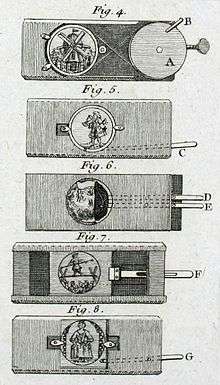
A common technique that is comparable to the effect of a panning camera makes use of a long slide that is simply pulled slowly through the lantern and usually shows a landscape, sometimes with several phases of a story within the continuous backdrop.
Some suggestion of movement was simply achieved by alternating between pictures of different phases of a motion, but most magic lantern animations used two glass slides projected together, one with the stationary part of the picture and the other with the part that was to move. Variations include:
- slipping slides: the moving part was simply slipped over the stationary one by hand (or with a small drawbar attached to the slide). Many of these slides showed before and after effects or beginning and end phases of a repetitive movement. These slides were supposed to be operated quickly and resulted in jerky movements. (see: Fig. 6 on the illustration by Petrus van Musschenbroek: a man, his wig and his hat). Some slides had moving parts that could be used for the illusion of more natural movements; a common example had a creature that could move the pupils in its eyes as if it was looking in all directions. Quite convincing illusions of moving waves on a seas or lake could also be achieved with this method.[27] (see: Fig. 7 on the illustration by Petrus van Musschenbroek: a tightrope walker sliding across the rope)
- masking slides: many slipping slides and some other mechanical slides had black backgrounds on the stationary part and black paint on portions of the moving part(s) that would mask parts of the underlying image. This made it possible to hide the previous position of limbs or heads (as an example for quickly operated versions), or make a nose grow very long (as an example for gradual movement).[27]
- lever slides: the moving part was operated by a lever. These could show a more natural movement than slipping slides and were mostly used for repetitive movements, for instance a woodcutter raising and lowering his axe, or a girl on a swing.[27] (see: Fig. 5 on the illustration by Petrus van Musschenbroek: a drinking man raising and lowering his glass + Fig. 8: a lady curtsying)
- pulley slides: a pulley rotates the moving part and could for instance be used to turn the sails on a windmill[28] (see: fig. 4 on illustration by Van Musschenbroek)
- rack and pinion slides: turning the handle of a rackwork would rotate or lift the moving part and could for instance be used to turn the sails on a windmill or for having a hot air balloon take off and descend. A more complex astronomical rackwork slide showed the then known eight planets and their satellites orbiting around the sun.[27] A version with a trapeze artist with articulated joints showed extra motion in bending and jiggling limbs.
Mechanical slides with different special effects include:
- the Chromatrope (invented 1846 by Sir David Brewster), which produced dazzling colorful geometrical patterns by rotating two glass discs in opposite directions with a double rackwork or pulley mechanism[27]
- the Eidotrope, a colourless variation of the Chromatrope using counter-rotating perforated metal discs[27]
- the 'Kaleidotrope, a slide with a single perforated disc connected with a string, which produces spots of light assuming a great varierty of curves[29]
- the Cycloidotrope (circa 1865) which had an adjustable stylus bar drawing geometric patterns on sooty glass while hand cranked during projection.[30]
- a Moiré pattern slide with two, contra rotating, brass rimmed discs perforated with a regular pattern of small holes[30]
- a Newton colour wheel slide which, when spinning it fast enough, blends seven colours into a white circle[30]
- a snow effect slide, which adds snow to another slide (preferably of a winter scene) by rotating a flexible loop of material pierced with tiny holes[30]

Dissolving view slides were produced since the 1840s for lanterns with two or more lenses. To dissolve from one slide to another a mechanical device could be fitted on the magic lantern, which locked up the a diaphragm on the first slide slowly whilst a diaphragm on a second slide was opened simultaneously. Typical examples had landscapes that dissolved from day to night or from summer to winter.[27]
There have been many different experiments involving sorts of movement with the magic lantern. These include:
- galvanometer slide: a flattened coil with a magnetized needle moving from side to side when a battery is connected.
- projection of moving frog legs, with the nerves and muscles of severed frog legs connected to electric wires.
- hour-glass projection: the projection of a flattened hourglass showed the sand flowing upwards. Extreme magnification made the effect extra impressive, with the grains of sand forming a wave-like pattern.
- cohesion figure projection of liquids: different oils and fats create all kinds of moving patterns when manipulated between clear glass plates or a narrow glass box.
Several of these experiments were publicly demonstrated at the London Polytechnic Institution.[29]
Systems with actual animation techniques
Versions of the magic lantern were used to project transparent variations of the phénakisticope. These were adapted with a mechanism that spins the disc and a shutter system. Duboscq produced some in the 1850s and Thomas Ross patented a version called "Wheel of life" in 1869 and 1870.[31]
The Choreutoscope was invented around 1866 by the Greenwich engineer J.Beale and demonstrated at the Royal Polytechnic. It projected six pictures from a long slide and used a hand-cranked mechanism for intermittent movement of the slide and synchronized shutter action. The mechanism became a key to the development of the movie camera and projector. The Choreutoscope was used at the first professional public demonstration of the Kinetoscope to explain its principles.[32]
An "Optical Instrument" was patented in the U.S. in 1869 by O.B. Brown, using a phenakistiscope-like disc with a technique very close to the later cinematograph; with Maltese Cross motion; a star-wheel and pin being used for intermittent motion, and a two-sector shutter.[33]
Phantasmagoria
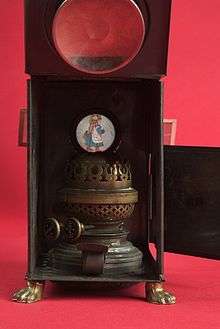
The later part of the 18th century was the age of Romanticism and the Gothic novel. There was an obsession with the bizarre and the supernatural.[34] Use of the magic lantern by charlatans who claimed to summon ghosts was quite common. Sometimes this was practiced in religious ceremonies. For example, Count Cagliostro used it to "raise dead spirits" in Egyptian masonry rituals. Johann Georg Schröpfer began using the magic lantern in séances in the 1760s and added many tricks including mirror projections, hollow voices issuing from hidden speaking tubes, assistants impersonating ghosts, the eerie sounds of a glass harmonica, thunderclaps and projection on smoke. Schröpfer later went insane, thinking he was pursued by real devils, and shot himself after promising an audience he would later resurrect himself.[35]
Paul Philidor refined the techniques, including mounting the lantern on a trolley. In his shows he led people into thinking that he had summoned ghosts by requests and raised spirits of revolutionary figures. However, Philidor's show was eventually closed by the authorities due to their paranoia.[35] The audiences of these magic lantern shows reacted to the projections with bewilderment. They thought the projections were real dreams, visions, apparitions and ghosts, and the devil. This was just fueled by the fact that this is exactly what the early conjurers and magicians used them for: scaring people using these ghostly images.[36]
The next famous conjurer to utilize the magic lantern was Etienne-Gaspard Robert, a Belgian inventor with an interest in magic. He held his first "fantasmagorie" at Pavillon de l'Echiquier in Paris. He began experimenting in the 1780s with techniques used to make phantasmagorias, which is basically the use of the magic lantern to conjure up supernatural images such as the devil, phantoms, or ghosts. If the images were projected onto a gauze screen, they would even seem to be floating in mid-air, making the stunt even more believable. At Pavillon de l'Echiquier, Robertson set up a public phantasmagoria and told the audience he would conjure up their dead relatives. He conjured up an image of a phantom with a dagger, and then pictures of the dead relatives. After this show, he continued to make other, bigger, more outrageous spectacles.[37] He put the magic lantern onto wheels and patented this under the name of 'fantascope'.[34] He eventually moved his work to a theater, where he built up a show to a grand finale in which large shapes moved around the otherwise dark theater.[37]
Robertson also used mechanical slides to make his images move. There is a small collection of transparencies at Conservatoire National des Arts et Métiers in Paris which shows a two-piece slide he used with one glass showing the face of a phantom and the other which had the image of the eyes, which when used meant the eyes could roll back and forth. Also, Robertson used multiple lanterns to project both a moving figure as well as a background for that figure. For example, a stationary projector in the front would have projected an image of a church courtyard while a moving projector from behind would project the image of the phantom The Bleeding Nun, an image which came from the novel The Monk by Matthew Gregory Lewis.[34] His shows were extremely successful.[37] The popularity increased and eventually this phenomenon moved to England. Many observers have been quoted saying these "ghosts" were very realistic, which is partly due to people's eyes not being trained to the phenomenon of photography and cinematography like ours today are.[37]
Today
Some enthusiasts claim that the brilliant quality of color in lantern slides is unsurpassed by successive projection media. The magic lantern and lantern slides are still popular with collectors and can be found in many museums. However, of the original lanterns from the first 150 years after its invention only 28 are known to still exist (as of 2009).[15] Museums usually prefer not to use their slides for projections, but often provide video representations of the slides.
A collaborative research project of several European universities called A Million Pictures started in June 2015 an will last until May 2018. It addresses the sustainable preservation of the massive, untapped heritage resource of the tens of thousands of lantern slides in the collections of libraries and museums across Europe.[38]
Genuine public lantern shows are relatively rare; several regular performers state to be the only one of their kind in their part of the world. These include Pierre Albanese and glass harmonica player Thomas Bloch live Magic Lantern/Phantasmagoria shows since 2008 in Europe[39] and The American Magic-Lantern Theater.[40] The Magic Lantern Society maintains a list of active lanternists, which contains more than 20 performers in the U.K. and circa eight performers in other parts of the world (Europe, U.S., Canada, Australia and New Zealand).[41]
Dutch theatre group Lichtbende produces contemporary magical light spectacles with magic lanterns, as well as magic lantern workshops.[42]
See also
- Slide projector
- Projector (disambiguation) for a directory of projector types
- Phantasmagoria
- Zoopraxiscope
- Film
References
- ↑ Pfragner, Julius. "An Optician Looks for Work". The Motion Picture: From Magic Lantern to Sound. Great Britain: Bailey Brothers and Swinfen Ltd. 9-21. Print.
- ↑ "All about lantern slides (1)".
- ↑ "All about magic lantern slides (2)".
- ↑ "All about lantern slides (1)".
- ↑ U.S. Patent US7784 A: Improvement in photographic pictures on glass.
- ↑ Timby, Kim (2016). Glass Transparencies: Marketing Photography’s Luminosity and Precision.
- ↑ "Historic Camera: William and Frederick Langenheim".
- ↑ Waddington, Damer. "Introduction". Panoramas, Magic Lanterns and Cinemas. Channel Islands, NJ: Tocan Books. xiii-xv. Print.
- ↑ Snyder, Laura J. (2015). "Eye of the Beholder".
- 1 2 3 4 Rossell, Deac (2002). "The Magic Lantern".
- ↑ Huygens, Christiaan. "Pour des representations par le moyen de verres convexes à la lampe" (in French).
- ↑ Huygens, Christiaan (1662-04-19). "letter to Lodewijk Huygens" (in French).
- ↑ Huygens, Christiaan (1694). "Aanhangsel II bij het eerste Complement van de Dioptrica" (in Dutch).
- ↑ "mageng.html".
- 1 2 Rossell, Deac (2009), "Early Magic Lantern Illustrations: What Can They Tell Us About Magic Lantern History?" (PDF), The Magic Lantern Gazette
- ↑ Kircher, Athanasius (1671). Ars Magna Lucis et Umbrae (in Latin). pp. 767=769. Retrieved 19 August 2010.
- 1 2 Kircher, Athanasius; Rendel, Mats. "About the Construction of The Magic Lantern, or The Sorcerers Lamp".
- ↑ "The mystery of the wrongly placed lenses (luikerwaal.com)".
- ↑ "The miracle of the magic lantern".
- ↑ Petit, Pierre (1664-11-28). "letter to Christiaan Huygens".
- ↑ http://www.mitpressjournals.org/doi/pdf/10.1162/TNEQ_a_00418
- ↑ "Holden, Moses (DNB00) - Wikisource, the free online library". en.m.wikisource.org. Retrieved 2015-09-17.
- ↑ http://www.victorianmicroscopeslides.com/pdf/pcarpenter.pdf
- ↑ Philip Carpenter, 1823, A Companion to the Magic Lantern: Part II.
- ↑ Van Musschenbroek, Pieter (1739). Beginsels Der Natuurkunde.
- ↑ Rossell, Deac (2005). The Magic Lantern and Moving Images before 1800.
- 1 2 3 4 5 6 7 "Luikerwaal - Mechanical Slides".
- ↑ "Magic lantern - collection of moving magic lantern slides part 1.". Luikerwaal.
- 1 2 Hepworth, T.C. (1888). The book of the lantern. pp. 171–203.
- 1 2 3 4 "Luikerwaal - Mechanical special effects slides".
- ↑ Herbert, Stephen. "Projection Phenakistoscope 1". www.stephenherbert.co.uk. Retrieved 19 July 2016.
- ↑ Rossell, Deac (1998). Living Pictures: The Origins of the Movies.
- ↑ U.S. Patent No. 93,594. August 10, 1869.
- 1 2 3 Barber, Theodore X. "Phantasmagorical Wonders: The Magic Lantern Ghost Show in Nineteenth-Century America." Film History 3,2 (1989): 73-86. Print.
- 1 2 Eds. Crangle, Richard, Heard, Mervyn, and van Dooren, Ine. "Devices and Desires". Realms of Light. London, England: The Magic Lantern Society, 2005. 11-45. Print.
- ↑ Vermeir, Koen. "The Magic of the Magic Lantern (1660-1700): On Analogical Demonstration and the Visualization of the Invisible." British Journal for the History of Science 38,2 (2005): 127-159. Print.
- 1 2 3 4 Castle, Terry. "Phantasmagoria and the Metaphorics of Modern Reverie." The Female Thermometer. New York, NY: Oxford University Press, 1995. 140-167. Print.
- ↑ "A Million Pictures (website)".
- ↑ http://www.thomasbloch.net/en_performances.html
- ↑ http://www.magiclanternshows.com/introducing.htm
- ↑ "Active Lanternists: The Magic Lantern Society".
- ↑ "Lichtbende - Magic Lantern".
External links
| Look up magic lantern in Wiktionary, the free dictionary. |
| Wikimedia Commons has media related to Magic lanterns. |
- luikerwaal.com Magic Lantern site 'de Luikerwaal'. Comprehensive information on the use and history of the Magic Lantern
- magic-lantern.eu website with more than 8000 lantern slides online
- Cinema and its Ancestors: The Magic of Motion Video interview with Tom Gunning
- A live Magic Lantern performance with accompaniment of crystal instruments is proposed here – feat. Pierre Albanese and Thomas Bloch
- Live Magic Lantern Shows The American Magic Lantern Theater
- Magic Lantern – A School of Cinema Film Institute Chennai
- University of Tasmania Library Lantern Slide Collection
- LUCERNA - The Magic Lantern Web Ressource
- The Magic Lantern Society An introduction to lantern history featuring images of lanterns, slides, and lantern accessories
- Joseph Boggs Beale collection of magic lantern illustrations, Margaret Herrick Library, Academy of Motion Picture Arts and Sciences
- Images of Lantern Slides from the National Museum of Australia
- The Magic Lantern Society, United Kingdom
- The Lantern Slide Collection at the New-York Historical Society